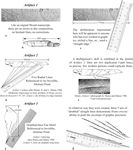
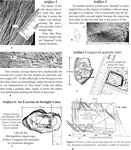


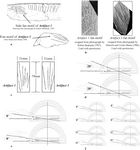


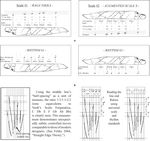
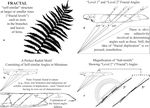
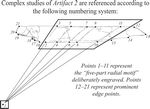




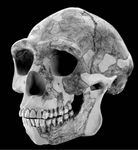
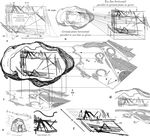
  |    |    |    |    |   |
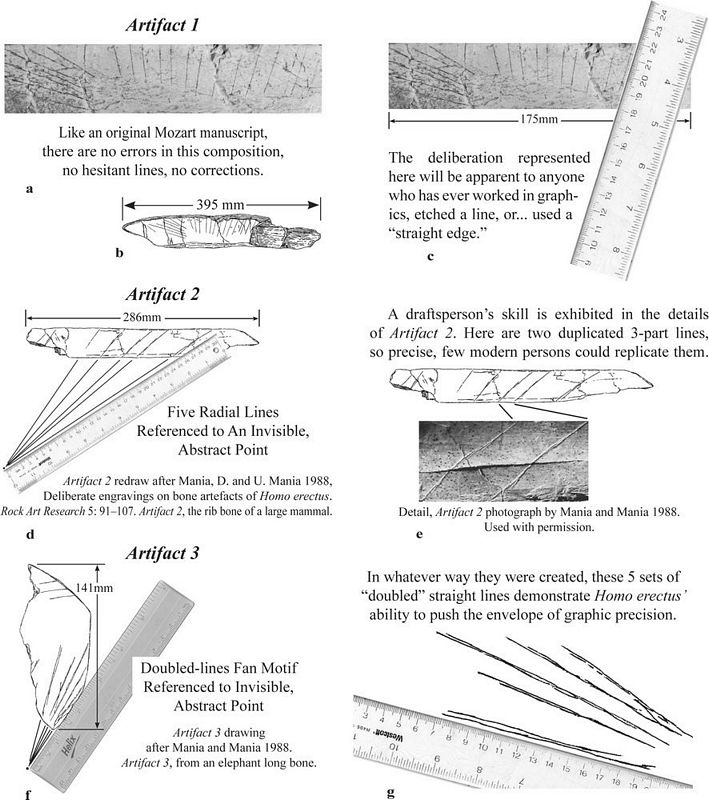 | Figure 1. Straight
edge theory: Artifacts 1–3. Note: The Artifacts 1–6
numbering system is from Mania and Mania 2005. Rulers were superimposed
by J. Feliks. (a & c) Detail, Artifact 1 engravings cropped from
photograph by R. Bednarik 1997. Used with permission. Artifact 1 is the
tibia bone of a straight-tusked elephant. (b) Artifact 1 after Mania
and Mania 1988. (d) Artifact 2, the rib bone of a large mammal, after
Mania and Mania 1988. (e) Detail, Artifact 2 engravings showing
duplicated 3-part compound motifs, cropped from photograph by Mania and
Mania 1988. Used with permission. (f) Artifact 3 after Mania and Mania
1988. (g) Close-up, double-engraved lines of Artifact 3. |
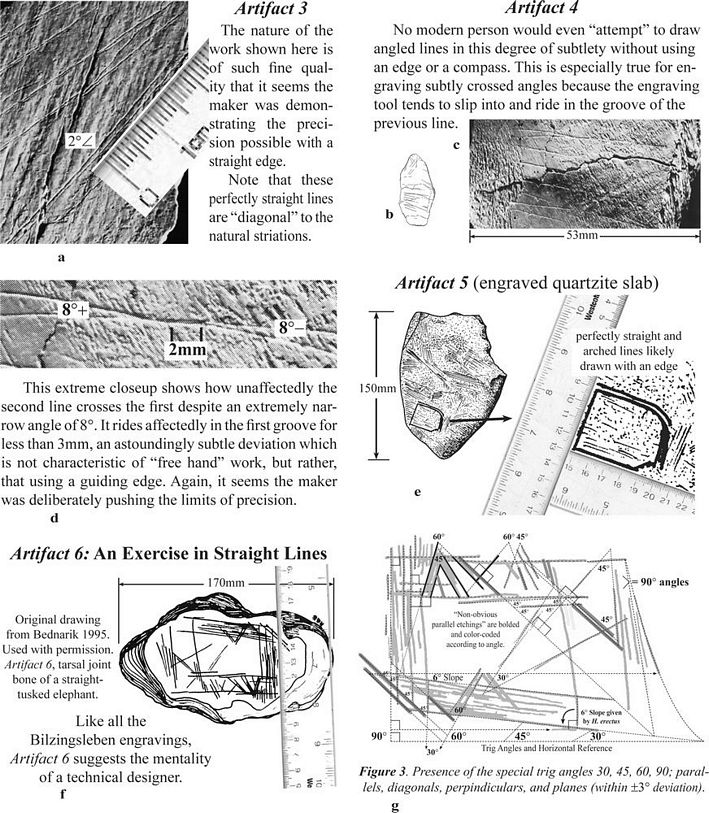 | Figure 2. Fig. 7.2. Straight edge theory, Artifacts 3–6. (a) Detail, Artifact 3, highlighting
an unambiguously straight engraved angle tapered at less than 2�
and comparable to modern standards of quality. Photograph by Mania and
Mania 1988. Used with permission.
(b) Artifact 4, a flat piece of bone, after Mania and Mania
1988. (c) Detail, Artifact 4 photograph, Mania and Mania 1988. (d)
Extreme close-up, Artifact 4 photograph. Mania and Mania 1988. Used
with permission. (e) Artifact 5. Bednarik 1995. Certainly, straight
lines engraved on a slab of stone cannot be explained away as
survival behavior. Used with permission. (f) Artifact 6. This work
represents either simple musings by someone fascinated with straight
lines and trig angles or a highly purposeful arrangement. (g)
Engravings from Artifact 6 isolated—highlighting presence of the
special trig angles 30, 45, 60, 90; parallels, diagonals, perpendiculars, and planes—all within �3� deviation.
Apart from a few slight curves, the draftsmanship consists entirely of
straight lines likely drawn with an edge. “Non-obvious parallel
etchings” were bolded and color-coded. |
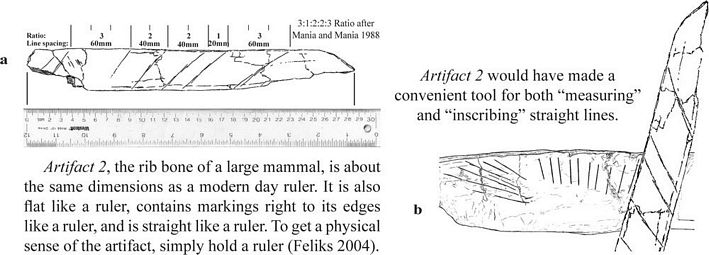 |
Figure 3. Proposed early straight edge. (a) Artifact 2 compared with a
modern ruler. (b) Proposed early straight edge in use. (Artifact 2
after Mania and Mania 1988, Artifact 1 drawing after photograph by R.
Bednarik 1997.). |
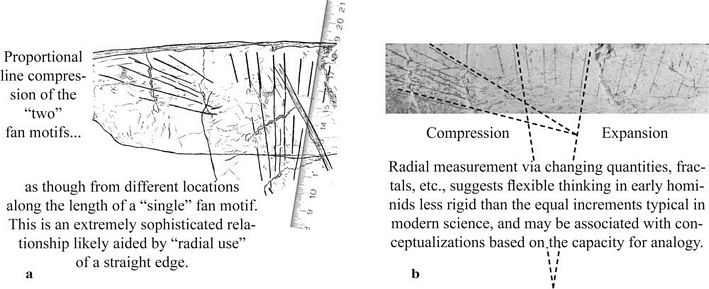 |
Figure 4. Straight edge theory and the “Realm of Ideas.” (a)
Proportional line compression of “two” fan motifs as though
from different locations along the length of a “single”
fan motif. Referring to Plato’s “realm of ideas” or
“theory of forms,” the two motifs in Artifact 1 suggest an
awareness of the fan shape or radial image in a way that transcends
simple observation of the physical world or as writers such as Morris
(1962) or Gowlett (1984) might refer to as a “mental
template.” (b) Compression-expansion and one means by which
radial measurement (or ratio measurement as in the Part 2 paper) can be
a geometric equivalent of analogy (Artifact 1 drawing after photograph
by Bednarik 1997, Detail Artifact 1 cropped from photograph by R.
Bednarik 1997. Used with permission.). |
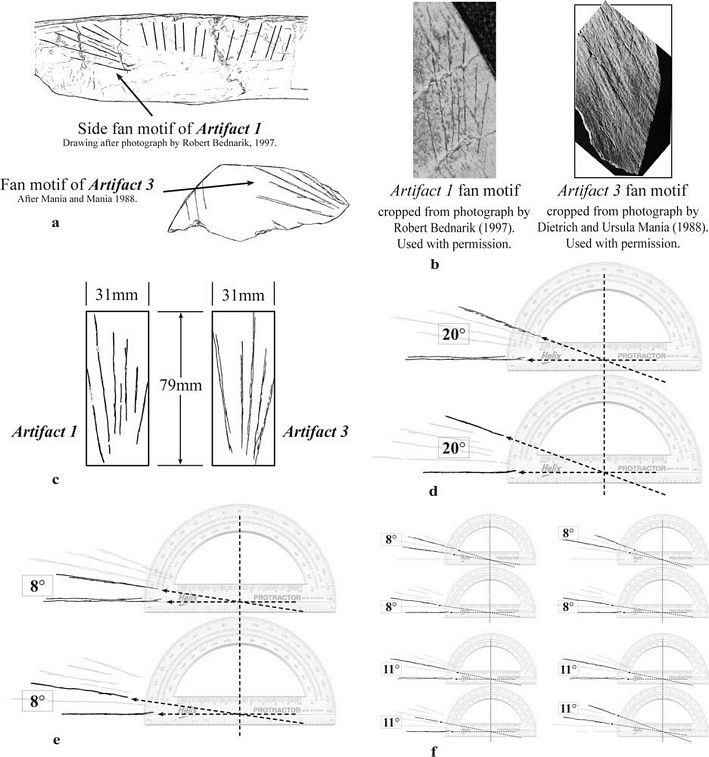 |
Figure 5.The
earliest motif duplicated on two separate artifacts. Part 1. (a) The
motifs in context with other syntactic variables. (b) Photographs. (c)
Observation 1: The motifs are the same size. (d) Observation 2: The
motifs share “identical” outer angles. (e) Observation 3:
The motifs share identical “inner” angles. (f) Observation
4: The motifs share many other identical angles. Beyond the angles
detailed in this paper, there are at least 5 more near identical angles
and more than 10 other angles that are within one degree of each other.
The difference with these additional angles is that they do not share
the same radial points. |
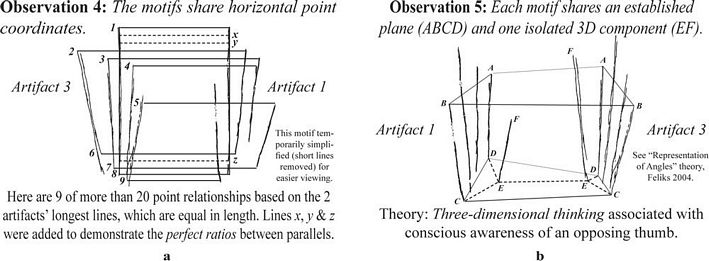 |
Figure 6. The earliest motif duplicated on two separate artifacts, Part 2. In
each of these studies, the two smallest lines of Artifact 1 have been
hidden so as to make the similarities readily visible. The effects
demonstrated here remain the same with or without the two smaller
lines. Even though graphics are usually laid out in two dimensions,
they reflect the internal world of three-dimensional thinking. 3D
studies offer access to the three-dimensional mind of Palaeolithic
peoples. (a) Although the two motifs appear different on the surface,
when they are compared via a Cartesian grid approach, they are each
seen to account for “most” of the same points, merely by
different means. (The effect of how things can appear quite different
on the surface yet be quite alike on a fundamental level is easy to
grasp when one compares a scallop shell, for instance, with an octopus.
Although completely different in external appearance they are closely
related internally, and are each classified as mollusks.) (b) Comparing
and interpreting two lines (each labeled EF) as positioned on
“separate planes” from the other lines in each set
(collectively labeled ABCD and interpreted as defining two planes). |
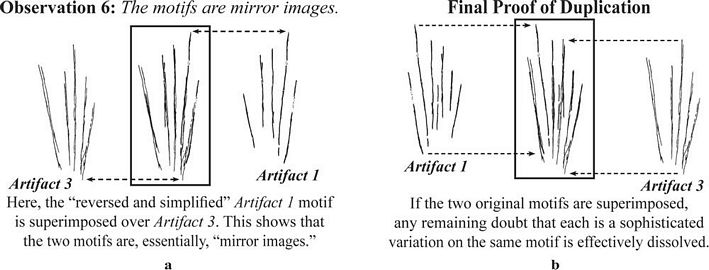 |
Figure 7.
The earliest motif duplicated on two separate artifacts, Part 3. (a)
The two motifs superimposed with the Artifact 1 motif flipped in
reverse. (b) The two motifs, with all lines present, superimposed
according to their standard orientation. One way to test the veracity
of the duplicated motif theory is to find out if any modern persons
could duplicate such precision as indicated here. Computers aside, I
propose that even in modern times these two motifs could not be
duplicated this accurately without a straight edge or protractor and
reference to the other image or its outer angle and vertex. |
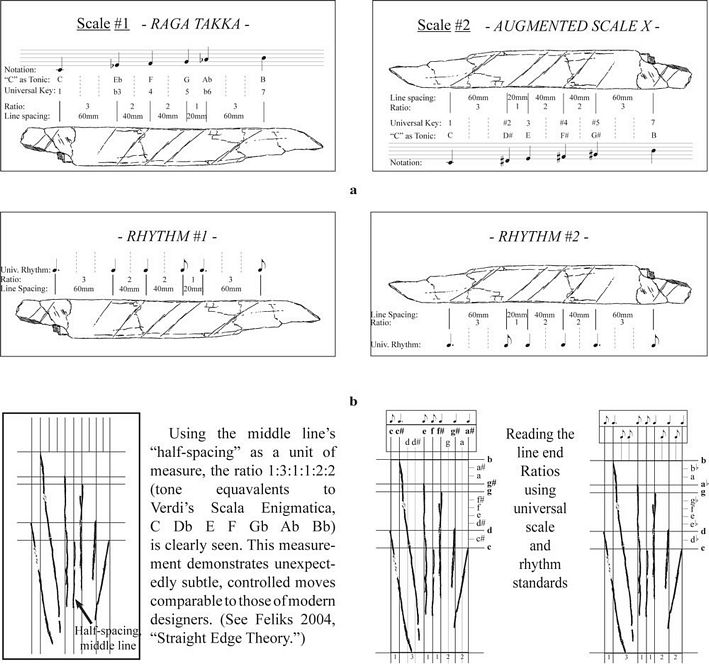 | Figure 8. 350,000
years before Bach. Reading the mathematical ratios by way of universal
key and rhythm standards. These studies were inspired by Mania and
Mania’s 1988 discovery of a mathematical ratio in the Artifact 2
engravings, namely, 3:1:2:2:3. As explained in a prior paper (Feliks
2006), these ratios are applicable to the concepts of pitch, rhythm,
and syntax in Palaeothic language. (a) Artifact 2 musical scales and
rhythms, only a few examples. (b) Artifact 1 side-fan motif “line
end ratios,” measuring the ratios by universal key and rhythm
standards. Note: spacing of vertical lines in these studies was
“tempered” for easier viewing. The tolerances applied are
clearly visible and are used for this interpretation only; they are not
suggested as the only interpretation. The deviations are within 2%,
inconsequential by archaeological standards. Side-fan motif redrawn
after photograph by R. Bednarik 1997. |
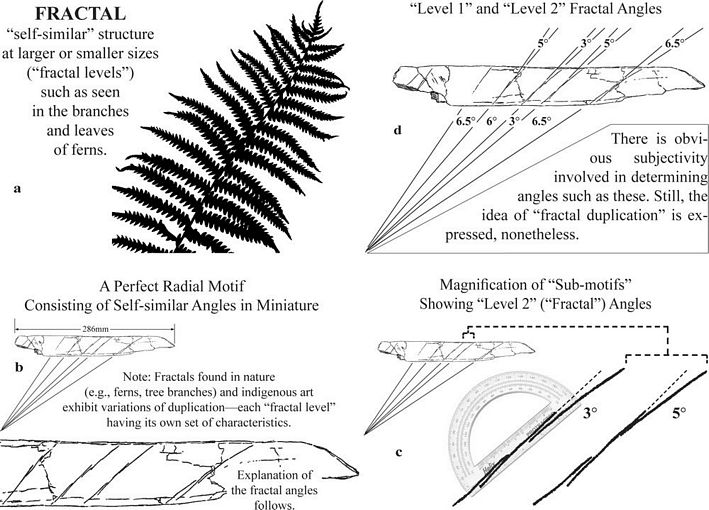 |
Figure 9. Fractal angle symmetry. (a)
Definition of fractal, with natural world example: living fern scan
(Feliks 1998). (b) Two views of Artifact 2 radial motif showing
“Level 1” angles (upper image) consisting of sub-motif
self-similar “Level 2” angles (lower image). Awareness of
fractals is a geometric equivalent to awareness of analogy. (c)
“Magnification of sub-motifs showing “Level 2”
fractal angles in Artifact 2. Very notable is the engraved 3�
angle. As with the 2� angle of Fig. 2a, a 3� angle is stunning
by any standards. (d) “Level 1” and “Level 2”
fractal angles in Artifact 2. These self-similar angles exhibit even
more sophisticated variations than detailed here such as diminution and
augmentation (Feliks 2008: Figures 8, 9, and 18). Most of the math
regarding fractals has only been developed during the past 25 years.
However, roots in ancient Africa are now known (e.g., Eglash 1999).
Artifact 2 drawing after Mania and Mania 1988. |
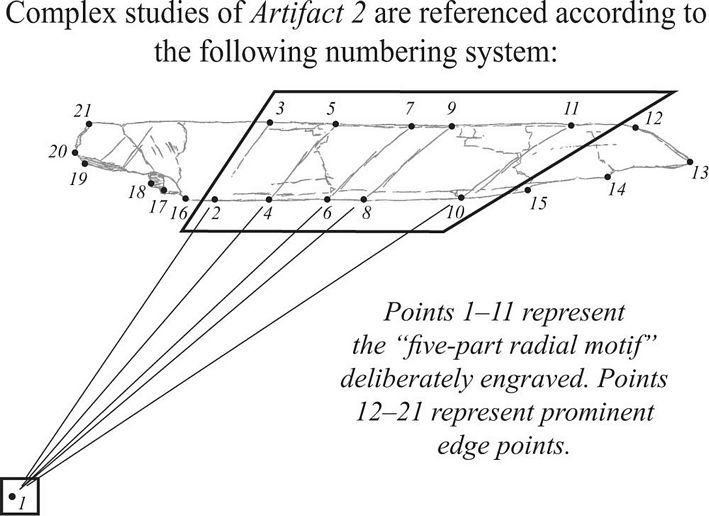 |
Figure 10. Numbering
system for the radial motif of Artifact 2. Lines which do not
participate in the radial motif are not focused upon in this particular
series. If the two small engraved lines at the left side of Artifact 2
are needed, their points may be referred to as 18a, 18b, and 21a, 21b. |
 |
Figure 11. Three-level,
self-similarity fractal characterized by parallels in thirds.
Interpreting components of the central double-motif as parallel rather
than subtly radial, they are seen to perfectly echo the structure and
basic angles of the entire artifact—whether rotated left or
rotated right. Level 1 is the doubled composite motif. Level 2 is the
motif duplicated three times in a row where it is seen to align
perfectly with parallels 21-16, 3-8, 9-15 and 12-13. Level 3 is the
double composite motif enlarged to the length of the entire artifact,
at which point it is seen to still align with these very same
parallels. While seeming like an inexplicable puzzle, it is simply more
evidence of fractal mental structure in Homo erectus, the acceptance of
which will be indispensable in understanding their language
capabilities. It is notable that this interpretation works whether the
motif is rotated to the left or rotated to the right. In Bach’s
famous Art of the Fugue (his final work), Contrapunctus XII and XIII
are known as “mirror fugues,” working equally well played
forward or backward. Also, one of the mirrors is
“upside-down,” while the other is a syntax inversion (see
Part III). This same level of mathematical symmetry was also
demonstrated by the radial motifs of Bilzingsleben Artifacts 1 & 3
(Fig. 7), that matched each other whether superimposed in standard
positioning or as mirror images. (a) left rotation. (b) right rotation. |
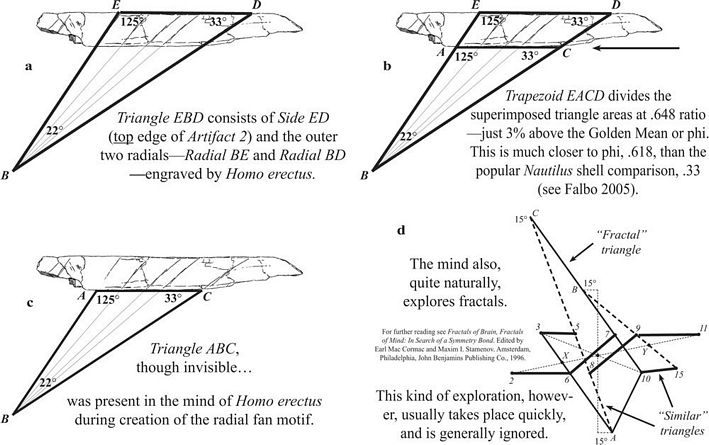 |
Figure 12. Invisible
shapes. All angle measurements are based on the original drawing by
Mania and Mania 1988. (a) Radial motif of Artifact 2 pointing to
invisible vertex, and defining a triangle. (b) Bottom edge of Artifact 2
divides the triangle into a smaller “fractal triangle” and
a trapezoid. (c) The earliest completely abstract and measurable
two-dimensional shape. (d) Excerpt from symmetric asymmetry studies.
This one shows fractal extensions from the Artifact 2 central doubled
motif, the same motif as in Fig. 11. |
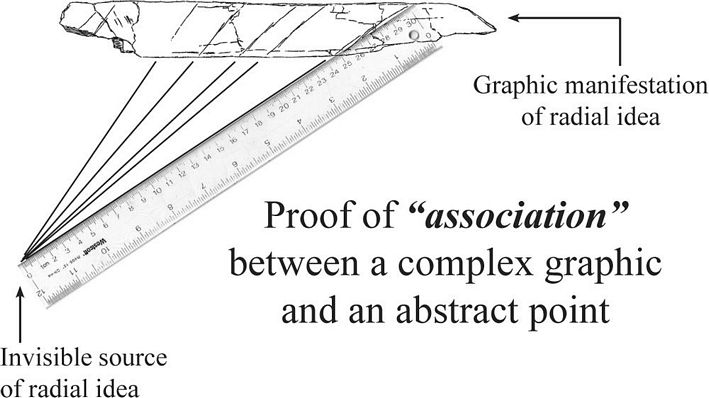 |
Figure 13. Proof
of association between a complex graphic and an abstract point.
Explanation: First, the primary engravings of Artifact 2 consist of
repeating and varying composite fractal elements (see Figures 9, 11,
and 14) which form a larger radial motif by way of self-similar fractal
angles; this is what makes it a “complex” graphic. Second,
the radial motif is traced backwards to an invisible point in space.
This study suggests that the abstraction abilities necessary for
complex language in which an arbitrary word stands for something which
is not visually or audibly similar was already fully developed by the
time of Bilzingsleben 400,000 years ago. Artifact 2 after Mania and
Mania 1988. |
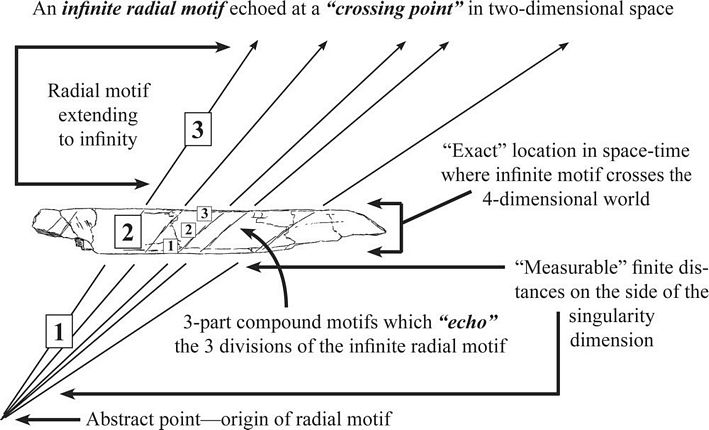 |
Figure 14. Proof
of association between an abstract point and infinity. As in the
complex works of Bach, which have sometimes been described as hinting
at infinite structures, the 3-part composite nature of the Artifact 2
engravings, likewise, suggest an infinite structure. Put in other
terms, the fractal location of the artifact itself within the infinite
radial motif is suggested by the middle segments of each 3-part
composite line, which appear to have been conceived of as
“breaks” in continuous radial lines, clearly
“in-between” two directions of sight or thought.
Conclusion: The inhabitants of Bilzingsleben were easily capable of
abstract concepts at any level of complexity. |
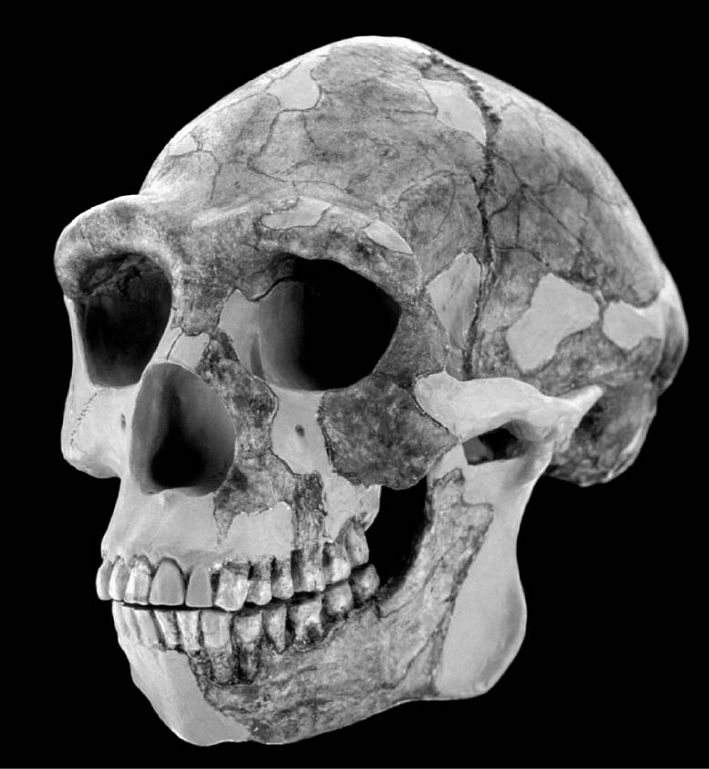 |
Figure 15. Who
were the people of Bilzingsleben? Putting a face on the Lower
Palaeolithic. In addition to their many shared cultural traits, the
inhabitants of Bilzingsleben were similar in physical appearance to
Homo erectus people living all over the Lower Palaeolithic world in
Africa, China, and Indonesia as far back as 1.7 million years ago
(Vlček 1978, 2002). This is Homo erectus from Zhoukoudian, China, also
known as “Peking Man.” Skull reconstruction by I.
Tattersall and G.J. Sawyer. Photograph courtesy of David Brill. |
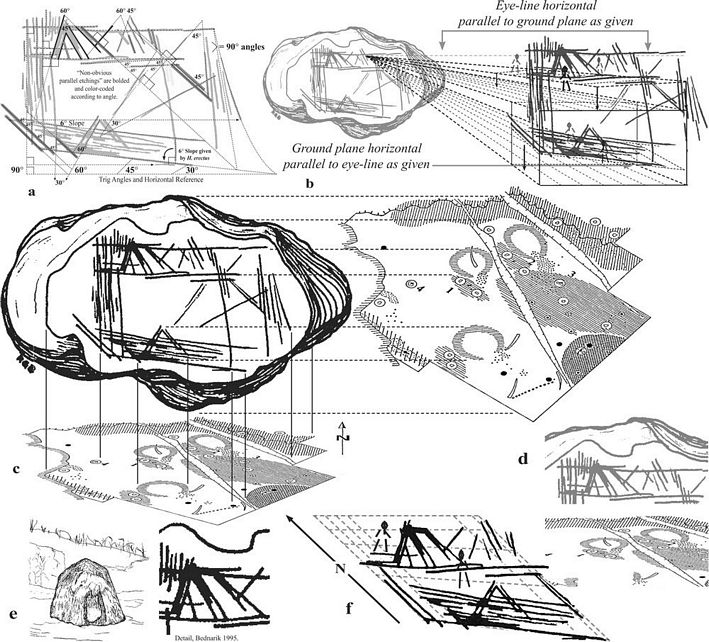 |
Figure 16. When
a map is a 3D fractal. (a) Non-iconic interpretation of Artifact 6
demonstrates, at the very least, presence of the special trig angles
30, 45, 60, 90; parallels; diagonals; perpendiculars; and
planes—all within �3� deviation, and all likely drawn
with the aid of a straight edge. Trig skills are important in
surveying, mapmaking, navigation, and astronomy. (b) Seeing the planes
as two tiers of a 3D map. If Artifact 6 is a map, it represents a
remarkable solution by H. erectus
to 3D problem. Note that the eye-line horizontal is parallel to the
ground plane (as “given” by H. erectus in the lower
horizontal registration notch labeled “6� Slope” in the
lower right corner of the central square of Fig. 16a; parallel
registration for the upper plane is visible both directly above the
lower registration and to the upper left), theoretically locating the
artist-cartographer in an elevated position, probably about 35 meters
away from the northernmost “huts.” Ground-plane to
eye-line-plane, ground-plane to observer elevation, and
observer-to-huts, are measurable distances using techniques of
trigonometry and a few basic assumptions. Notice other aspects of 3D
perspective style including hut, ground, and angle references, depth
increments (lower plane), occlusion (upper plane), and cardinal
directions. (c) Comparing Artifact 6 (UPPER LEFT, Bednarik 1995) with
angular views of the entire site from the shoreline south as in the
original archaeological map by Mania and Mania 1988. BELOW: Site map
angled to match the lower plane in Artifact 6. RIGHT: Site map angled
to match the hut lines and demonstrate how the entire site is accounted
for (including unanticipated nonrelief [unless the “6�
Slope” and implied position of cartographer are considered]
topographic features) in Artifact 6. (d) Comparing the upper plane of
Artifact 6 with the two northernmost huts in the archaeological map.
The map has been angled to resemble the plane suggested in the
engraving. North orientation is preserved not only in the map, but in
the artifact as well by way of its unambiguously engraved 90�
corner. (e) LEFT: Life-size reconstruction of Bilzingsleben hut (after
photo, Praehistoria Thuringica,
September 2004). RIGHT: Detail from the Artifact 6 sketch perhaps by
someone actually involved in the original hut’s construction,
400,000 years ago. (f) The two planes of Arfitact 6 brought to a single
plane and lined up via the parallel left-right oblique
“registration guides.” As a 2D map, the upper-left right
angles of Artifact 6 are taken as NSEW. In the 3D interpretation, the
“exactly parallel” doubled oblique registration guides are
taken as NS. Remarkably, reading the artifact in this way still matches
NSEW of Mania and Mania’s original archaeological map. |